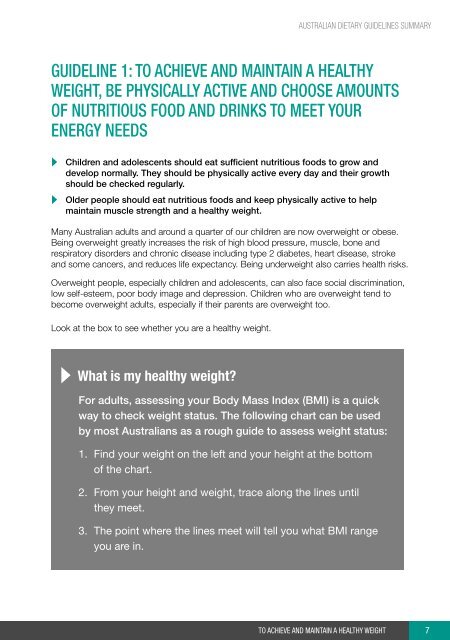Australian Dietary Guidelines - Summary - National Health and ...
Australian Dietary Guidelines - Summary - National Health and ...
Australian Dietary Guidelines - Summary - National Health and ...
- No tags were found...
Create successful ePaper yourself
Turn your PDF publications into a flip-book with our unique Google optimized e-Paper software.
<strong>Australian</strong> <strong>Dietary</strong> <strong>Guidelines</strong> <strong>Summary</strong>Guideline 1: To achieve <strong>and</strong> maintain a healthyweight, be physically active <strong>and</strong> choose amountsof nutritious food <strong>and</strong> drinks to meet yourenergy needsChildren <strong>and</strong> adolescents should eat sufficient nutritious foods to grow <strong>and</strong>develop normally. They should be physically active every day <strong>and</strong> their growthshould be checked regularly.Older people should eat nutritious foods <strong>and</strong> keep physically active to helpmaintain muscle strength <strong>and</strong> a healthy weight.Many <strong>Australian</strong> adults <strong>and</strong> around a quarter of our children are now overweight or obese.Being overweight greatly increases the risk of high blood pressure, muscle, bone <strong>and</strong>respiratory disorders <strong>and</strong> chronic disease including type 2 diabetes, heart disease, stroke<strong>and</strong> some cancers, <strong>and</strong> reduces life expectancy. Being underweight also carries health risks.Overweight people, especially children <strong>and</strong> adolescents, can also face social discrimination,low self-esteem, poor body image <strong>and</strong> depression. Children who are overweight tend tobecome overweight adults, especially if their parents are overweight too.Look at the box to see whether you are a healthy weight.What is my healthy weight?For adults, assessing your Body Mass Index (BMI) is a quickway to check weight status. The following chart can be usedby most <strong>Australian</strong>s as a rough guide to assess weight status:1. Find your weight on the left <strong>and</strong> your height at the bottomof the chart.2. From your height <strong>and</strong> weight, trace along the lines untilthey meet.3. The point where the lines meet will tell you what BMI rangeyou are in.TO ACHIEVE AND MAINTAIN A HEALTHY WEIGHT7
















